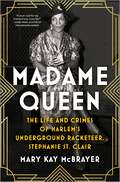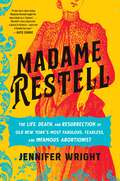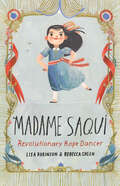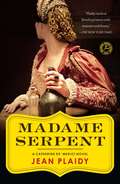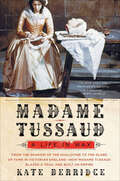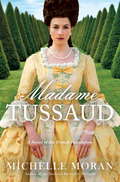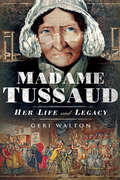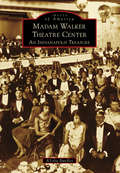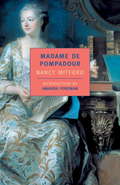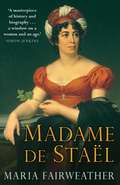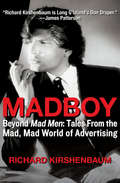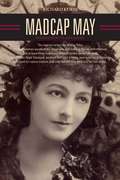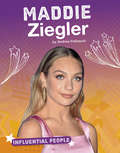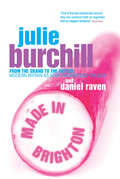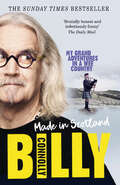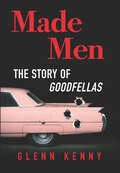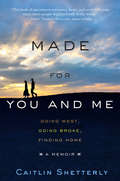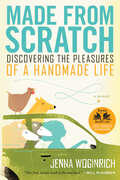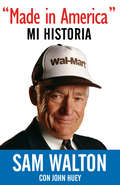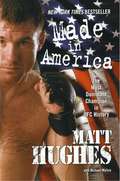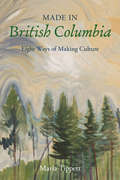- Table View
- List View
Madame Queen: The Life and Crimes of Harlem’s Underground Racketeer, Stephanie St. Clair
by Mary Kay McBrayerThe astonishing little-known history of Harlem racketeer Madame Stephanie St. Clair, one of the only female crime bosses and a Black, self-made businesswoman in early twentieth-century New York. In her heyday, Stephanie St. Clair went by many names, but one was best known by all: Madame Queen. The undeniable queen of the Harlem numbers game, St. Clair redefined what it meant to be a woman of means. After immigrating to America from the West Indies, St. Clair would go on to manage one of the largest policy banks in all of Harlem by 1923. She knew the power of reputation, and even though her business was illegal gambling, she ran it like any other respectable entrepreneur. Because first and foremost, Madame Queen was a lady. But that didn&’t stop her from doing what needed to be done to survive. St. Clair learned how to navigate the complex male-dominated world of crime syndicates, all at a time when Tammany Hall and mafia groups like the Combination were trying to rule New York. With her tenacity and intellectual prowess, she never backed down. Madame Queen was a complicated figure, but she prioritized the people of Harlem above all else, investing her wealth back into the neighborhood and speaking out against police corruption and racial discrimination. St. Clair was a trailblazer, unafraid to challenge societal norms. But for far too long she&’s been a footnote in more infamous characters&’ stories, like Bumpy Johnson, Dutch Schultz and Lucky Luciano. Now, in this masterful portrayal of a woman who defied the odds at all costs, she finally gets her due.
Madame Restell: The Life, Death, and Resurrection of Old New York's Most Fabulous, Fearless, and Infamous Abortionist
by Jennifer Wright**Longlisted for the Brooklyn Public Library Book Prize in Nonfiction (2023)** **An Amazon EDITOR'S PICK for BEST BOOKS OF 2023 SO FAR in BIOGRAPHY/MEMOIR and HISTORY** **An Amazon EDITOR'S PICK for BEST BOOKS OF THE MONTH (March 2023)** **A Bookshop.Org EDITOR'S PICK (March 2023)** &“This is the story of one of the boldest women in American history: self-made millionaire, a celebrity in her era, a woman beloved by her patients and despised by the men who wanted to control them.&” An industrious immigrant who built her business from the ground up, Madame Restell was a self-taught surgeon on the cutting edge of healthcare in pre-Gilded Age New York, and her bustling &“boarding house&” provided birth control, abortions, and medical assistance to thousands of women—rich and poor alike. As her practice expanded, her notoriety swelled, and Restell established her-self as a prime target for tabloids, threats, and lawsuits galore. But far from fading into the background, she defiantly flaunted her wealth, parading across the city in designer clothes, expensive jewelry, and bejeweled carriages, rubbing her success in the faces of the many politicians, publishers, fellow physicians, and religious figures determined to bring her down. Unfortunately for Madame Restell, her rise to the top of her field coincided with &“the greatest scam you&’ve never heard about&”—the campaign to curtail women&’s power by restricting their access to both healthcare and careers of their own. Powerful, secular men—threatened by women&’s burgeoning independence—were eager to declare abortion sinful, a position endorsed by newly-minted male MDs who longed to edge out their feminine competition and turn medicine into a standardized, male-only practice. By unraveling the misogynistic and misleading lies that put women&’s lives in jeopardy, Wright simultaneously restores Restell to her rightful place in history and obliterates the faulty reasoning underlying the very foundation of what has since been dubbed the &“pro-life&” movement. Thought-provoking, character-driven, boldly written, and feminist as hell, Madame Restell is required reading for anyone and everyone who believes that when it comes to women&’s rights, women&’s bodies, and women&’s history, women should have the last word.
Madame Saqui: Revolutionary Rope Dancer
by Lisa RobinsonA stunning picture book biography about the tightrope walker who dazzled Paris as she danced across the sky with impeccable balance and unparalleled skill during the French Revolution.In revolutionary France, a girl named Marguerite Lalanne longed to perform above large crowds on a tightrope, just like her acrobatic parents. Sneaking off to the fairgrounds for secret tightrope walking lessons, Marguerite finessed her performance skills, ultimately performing for crowds as a young rope dancer. And eventually, Marguerite would perform as Madame Saqui, waltzing and pirouetting across- and never falling off- countless ropes above adoring crowds. A nouvelle chérie de Paris, Madame Saqui cemented her place in circus history, winning the adoration of the French people and royalty alike, including Emperor Napoleon Bonaparte. This remarkable biography unveils the inspiring story of a trailblazing woman who revolutionized the circus world-- without ever missing a step.
Madame Serpent: A Catherine de Medici (Catherine de Medici, Book #1)
by Jean PlaidyFourteen-year-old Catherine de' Medici arrives in Marseilles to marry Henry, Duke of Orleans, second son of the King of France. The brokenhearted Catherine has left her true love in Italy, forced into trading her future happiness for marriage into the French royal family. Amid the glittering fêtes and banquets of the most immoral court in sixteenth-century Europe, the reluctant bride becomes a passionate but unwanted wife. Humiliated and unloved, Catherine spies on Henry and his lover, the infamous Diane de Poitiers. Tortured by what she sees, Catherine becomes consumed by a ruthless ambition destined to make her the most despised woman in France: the dream that one day the French crown will be worn by a Medici heir. . . .
Madame Tussaud: A Life in Wax
by Kate BerridgeKate Berridge’s Madame Tussaud: A Life in Wax “celebrates a great pioneer of mass-market illusion, whose illusions eventually included herself.”*Millions have visited the museums that bear her name, yet few know much about Madame Tussaud. A celebrated artist, she had both a ringside seat at and a cameo role in the French Revolution. A victim and survivor of one of the most tumultuous times in history, this intelligent, pragmatic businesswoman has also had an indelible impact on contemporary culture, planting the seed of our obsession with celebrity.Kate Berridge tells this fascinating woman’s complete story for the first time, drawing upon a wealth of sources, including Tussaud’s memoirs and historical archives. It is a grand-scale success story, revealing how with sheer graft and grit a woman born in 1761 to an eighteen-year-old cook overcame extraordinary reversals of fortune to build the first and most enduring worldwide brand identified simply by reference to its founder’s name: Madame Tussaud’s.“A good story, like Berridge’s biography, is a blessing.” —Miami Herald“A rousing good read . . . [Berridge] presents us with a thorough understanding of the beginnings of popular culture.” —Vancouver Sun“Fascinating. . . . A vividly recreated history of an extreme time and the unusually determined woman who capitalized so effectively on it.” —Globe and Mail“Spectacular and spellbinding. . . . Thoughtful, original, never condescending, erudite, and packed with vivid and sometimes horrifying detail, it is a model of how cultural history should be written.” —*Sunday Times (London)
Madame Tussaud: A Novel of the French Revolution (Bride Series)
by Michelle MoranThe world knows Madame Tussaud as a wax artist extraordinaire, but who was this woman who became one of the most famous sculptresses of all time? From the internationally bestselling author of Nefertiti comes a &“rollicking drama&” (Good Housekeeping) that is &“intimate and entertaining&” (Associated Press). &“Both a gripping, fictionalized biography of an intriguing woman and a well-paced, illuminating chronicle of the French Revolution.&”—New York Journal of Books Smart and ambitious, Marie Tussaud has learned the secrets of wax sculpting by working alongside her uncle in their celebrated wax museum, the Salon de Cire. From her popular model of the American ambassador, Thomas Jefferson, to her tableau of the royal family at dinner, Marie&’s museum provides Parisians with the very latest news on fashion, gossip, and even politics. Her customers hail from every walk of life, yet her greatest dream is to attract the attention of Marie Antoinette and Louis XVI; their stamp of approval on her work could catapult her and her museum to the fame and riches she desires. Though many people are starving and can no longer afford bread, Marie&’s business is booming. In salons and cafés across Paris, people like Maximilien Robespierre are lashing out against the monarchy. Soon, there&’s whispered talk of revolution. Spanning five years, from the budding revolution to the Reign of Terror, Madame Tussaud brings us into the world of an incredible heroine whose talent for wax modeling saved her life and preserved the faces of a vanished kingdom.
Madame Tussaud: Her Life and Legacy
by Geri WaltonA &“meticulously researched and deftly written biography&” of the woman behind the famed wax museums, and their origins in the era of the French Revolution (Midwest Book Review). Madame Marie Tussaud is known worldwide for the chain of wax museums she started over two hundred years ago. Less known is that her original wax models were often of the famous and infamous people she personally knew during and after the French Revolution. These were people like Voltaire, Robespierre, and Napoleon—people who changed the world. Even more, the wax figures were depicted in scenes drawn from the horrors she experienced during the reign of terror in Paris during her early adult years. This book shows how the traumatic and cataclysmic experiences of Madame Tussaud&’s early life became part of her legacy. She created a succession of scenes in wax, telling events as she personally experienced them. Her wax sculptures were visceral. She made them herself, at times from the living person&’s head and at other times from the recently guillotined head of a former houseguest. As a result, people were drawn to her wax displays because they were the most intense way of experiencing those events themselves. This is the story not only of a unique artist, but of how one of history&’s bloodiest events influenced her life and work.
Madame Walker Theatre Center: An Indianapolis Treasure (Images of America)
by A'Lelia BundlesAs they watched construction of the block-long flatiron building brick by brick throughout 1927, African American residents of Indianapolis could scarcely contain their pride. This new headquarters of the Madam C.J. Walker Manufacturing Company, with its terra-cotta trimmed facade, was to be more than corporate offices and a factory for what then was one of America's most successful black businesses. In fact, it was designed as "a city within a city," with an African Art Deco theater, ballroom, restaurant, drugstore, beauty salon, beauty school, and medical offices. Generations of African American families met for Sunday dinner at the Coffee Pot, enjoyed first-run movies and live performances in the Walker Theatre, and hosted dances in the Casino. Today, this National Historic Landmark is an arts center anchoring the Indiana Avenue Cultural District.
Madame de Pompadour
by Nancy Mitford Amanda ForemanWhen Madame de Pompadour became the mistress of Louis XV, no one expected her to retain his affections for long. A member of the bourgeoisie rather than an aristocrat, she was physically too cold for the carnal Bourbon king, and had so many enemies that she could not travel publicly without risking a pelting of mud and stones. History has loved her little better. Nancy Mitford's delightfully candid biography re-creates the spirit of eighteenth-century Versailles with its love of pleasure and treachery. We learn that the Queen was a "bore," the Dauphin a "prig," and see France increasingly overcome with class conflict. With a fiction writer's felicity, Mitford restores the royal mistress and celebrates her as a survivor, unsurpassed in "the art of living," who reigned as the most powerful woman in France for nearly twenty years.
Madame de Stael
by Maria FairweatherThe influence of the salons of Paris on the thought and culture of the eighteenth century would be difficult to overstate. They were both intellectual powerhouses and also assemblies where the latest and most extreme fashion was displayed.'Young gallants...wearing silk waistcoats embroidered with Chinese pagodas, making love to ladies reclining negligently against the cushions...or accepting small cups of chocolate from the hands of Negro pages', thus Harold Nicolson describes the drawings of the time in his book "The Age of Reason". These meeting places for the vanguard of society were presided over by a succession of brilliantly clever women, the salonieres, and the most brilliant and clever of all of them was Madame de Stael. Although she died at the age of 51 she filled her life to the brim, and enjoyed a hugely influential role among the great names of the day. Born Germaine Necker, in Paris on 22 April 1766, her father was a powerful banker and her mother a Swiss pastor's daughter who never got over her good fortune in marrying a rich man. In 1786 Germaine was married to a secretary in the Swedish embassy called de Stael, but although she thought him 'a perfect gentleman' she also found him dull and clumsy. She began to take lovers - the Vicomte de Narbonne and possibly Talleyrand - and then Benjamin Constant, in whom she at last met her intellectual equal. In 1806 her novel "Delphine" was published. It was an instant success and praised by Goethe and Byron, among others. Her salon thronged with glittering visitors including The Tsar, Talleyrand,and Wellington. Maria Fairweather gives an entrancing account of this vanished world, so merciless to outsiders, but for those of the inner circle incomparably glamorous and exciting.
Madame de Stael
by Maria FairweatherThe influence of the salons of Paris on the thought and culture of the eighteenth century would be difficult to overstate. They were both intellectual powerhouses and also assemblies where the latest and most extreme fashion was displayed.'Young gallants...wearing silk waistcoats embroidered with Chinese pagodas, making love to ladies reclining negligently against the cushions...or accepting small cups of chocolate from the hands of Negro pages', thus Harold Nicolson describes the drawings of the time in his book "The Age of Reason". These meeting places for the vanguard of society were presided over by a succession of brilliantly clever women, the salonieres, and the most brilliant and clever of all of them was Madame de Stael. Although she died at the age of 51 she filled her life to the brim, and enjoyed a hugely influential role among the great names of the day. Born Germaine Necker, in Paris on 22 April 1766, her father was a powerful banker and her mother a Swiss pastor's daughter who never got over her good fortune in marrying a rich man. In 1786 Germaine was married to a secretary in the Swedish embassy called de Stael, but although she thought him 'a perfect gentleman' she also found him dull and clumsy. She began to take lovers - the Vicomte de Narbonne and possibly Talleyrand - and then Benjamin Constant, in whom she at last met her intellectual equal. In 1806 her novel "Delphine" was published. It was an instant success and praised by Goethe and Byron, among others. Her salon thronged with glittering visitors including The Tsar, Talleyrand,and Wellington. Maria Fairweather gives an entrancing account of this vanished world, so merciless to outsiders, but for those of the inner circle incomparably glamorous and exciting.
Madboy: Beyond Mad Men: Tales from the Mad, Mad World of Advertising
by Richard KirshenbaumA thrilling and irreverent memoir about the transformation of the advertising business from the 1980s to todayRichard Kirshenbaum was born to sell. Raised in a family of Long Island strivers, this future advertising titan was just a few years old when his grandfather first taught him that a Cadillac is more than a car, and that if you can&’t have a Trinitron you might as well not watch TV. He had no connections when he came to Madison Avenue, but he possessed an outrageous sense of humor that would make him a millionaire. In 1987, at the age of twenty-six, Richard put his savings on the line to launch his own agency with partner Jonathan Bond, and within a year, had transformed it from a no-name firm into the go-to house for cutting-edge work. Kirshenbaum and Bond pioneered guerilla marketing by purchasing ad space on fruit, spray-painting slogans on the sidewalk, and hiring actors to order the Hennessy martini in nightclubs. They were the bad boys of Madison Avenue—a firm where a skateboarding employee once bowled over an important client—but backed up their madness with results. Packed with business insight, marketing wisdom, and a cast of characters ranging from Princess Diana to Ed McMahon, this memoir is as bold, as breathtaking, and as delightful as Richard himself.
Madcap May: Mistress of Myth, Men, and Hope
by Richard KurinMay Yohe was a popular entertainer from humble American origins who married and then abandoned a wealthy English Lord who owned the fabled Hope diamond--one of the most valuable objects in the world and now exhibited at the Smithsonian Institution in Washington, D.C. May was a romantic who had numerous lovers and at least three husbands--though the tabloids rumored twelve. One included the playboy son of the Mayor of New York. May separated from him--twice--and cared for her next husband, a South African war hero and invalid whom she later shot.Crossing the paths of Ethel Barrymore, Boris Karloff, Oscar Hammerstein, Teddy Roosevelt, Consuelo Vanderbilt, and the Prince of Wales, May Yohe was a foul-mouthed, sweet-voiced showgirl who drew both the praise and rebuke of Nobel laureate George Bernard Shaw. Nicknamed "Madcap May," she was a favorite of the press. In later years she faced several maternity claims and a law suit which she won. She was hospitalized in an insane asylum and escaped. She ran a rubber plantation in Singapore, a hotel in New Hampshire, and a chicken farm in Los Angeles. When all else failed, she washed floors in a Seattle shipyard, and during the Depression held a job as a government clerk. Shortly before her death, she fought, successfully, to regain her lost U.S. citizenship.How was this woman, May Yohe, able to charm her way to international repute, live an impossible life, and also find the strength to persevere in light of the losses she suffered--in wealth, citizenship, love, and sanity? Madcap May, assembled from her writings and historical interviews, archival records, newspaper stories, scrapbooks, photographs, playbills, theatrical reviews, souvenirs, and silent film, tells her heretofore lost story.
Maddie Ziegler (Influential People)
by Andrea PelleschiThe world saw Maddie Ziegler dance alongside pop star Sia. Now the young dancer is also a writer and actor. Learn more about Maddie's promising career!
Made In Brighton: From the grand to the gutter: Modern Britain as seen from beside the sea
by Julie Burchill Daniel RavenBritain is experiencing a sudden reckless rush of liberalisation, from 24 hour licensing to gay marriages. But how did we get from idolising Grace Kelly and Prince Rainier to Jordan and Peter Andre? Funny and bittersweet, Made In Brighton interweaves personal stories of life in Brighton with larger themes of sex, politics and class to take a cold, hard look at the changing face of Britain, and at the town which has always been at the vanguard of Britain's cultural evolution. From punk to dance, dope to coke, the Labour party to hen parties, straight to gay to bi, this book holds a mirror up to the dazed face of Britain and gives it a good hard slap.
Made In Scotland: My Grand Adventures in a Wee Country
by Billy ConnollyTHE SUNDAY TIMES BESTSELLER'Where do you come from? It's one of the most basic human questions of all. But there is another question, which might sound a wee bit similar but is actually very different: What do you come from? And, let me tell you, that question can take you all sorts of strange places...'In Made in Scotland, legendary comic and national treasure Billy Connolly returns to his roots, reflecting on his life, his homeland and what it means – then and now – to be Scottish. Full of Billy's distinctive humour, Made in Scotland is a hilarious and heartfelt love letter to the place and the people that made him.
Made Men: The Story of Goodfellas
by Glenn KennyA revealing look at the making of Martin Scorsese’s iconic mob movie and its enduring legacy, featuring interviews with its legendary cast.When Goodfellas first hit the theatres in 1990, a classic was born. Few could anticipate the unparalleled influence it would have on pop culture, one that would inspire future filmmakers and redefine the gangster picture as we know it today. From the rush of grotesque violence in the opening scene to the iconic hilarity of Joe Pesci’s endlessly quoted “Funny how?” shtick, it’s little wonder the film is widely regarded as a mainstay in contemporary cinema.In the first ever behind-the-scenes story of Goodfellas, film critic Glenn Kenny chronicles the making and afterlife of the film that introduced the real modern gangster. Featuring interviews with the film’s major players, including Martin Scorsese and Robert De Niro, Made Men shines a light on the lives and stories wrapped up in the Goodfellas universe, and why its enduring legacy has such a hold on American culture.A Library Journal Best Book of the YearA Sight and Sound Best Film Book of 2020
Made With Love: The Meals On Wheels Family Cookbook
by Enid BordenCelebrating the importance of family, Made With Love: The Meals On Wheels Family Cookbook includes recipes from the tables of well-known actors, chefs, writers, and other celebrities along with personal stories about their favorite family meals. Learn to cook: Patti LaBelle's Baja Fish Tacos Cokie Roberts' Artichoke Gratin Al Roker's New Orleans–Style Barbecued Shrimp Judi Dench's Bread and Butter Pudding Other contributors include Helen Mirren, Martha Stewart, former First Lady Barbara Bush, Mario Batali, Paula Deen, Joan Lunden, Kurt Warner, Dr. Maya Angelou, Joan Rivers, and many more. Providing more than a million meals a day for seniors across America, Meals On Wheels Association of America is the oldest and largest national organization of its kind. Each sale of Made With Love: The Meals On Wheels Family Cookbook helps to end senior hunger in America.
Made for This Moment: Standing Firm with Strength, Grace, and Courage
by Madison PrewettHow do you stand firm in your convictions in a world that's trying to pull you down? Madison Prewett helps you keep your standards high and your roots deep in this strikingly personal look at why you were made for this moment.When Madison Prewett competed on season 24 of The Bachelor, she was able to maintain her convictions not just because she was strong in the moment of pressure but because she was strong in the moments of preparation. In Made for This Moment, Madison examines how the biblical story of Esther will prepare you to:Discover how to predecide who you want to be before you step into your Big MomentsClaim your confidence so you can get out of the comparison gameLearn strategies for dealing with your past so it won't hinder your presentBreak free from the labels others put on youLearn how to respond to offense with grit and graceDiscover how to be yourself whether anyone is looking or notMade for This Moment will appeal to fans of Sadie Robertson, Jordan Lee Dooley, and Annie F. Downs, as well as to Madison's faithful following from her remarkable Bachelor season. Readers who are eager to make wise choices in dating, career, and family will love Madison's authentic voice and real-life challenges, making this a great gift for graduations, birthdays, or life transitions.Made for This Moment will help you navigate the complex realities of living in an age of social media and confusing standards. God's timing is not a mistake--you were made for such a time as this.
Made for You and Me: Going West, Going Broke, Finding Home
by Caitlin ShetterlyNewlywed Caitlin Shetterly and her husband, Dan Davis, two hardworking freelancers, began their lives together in 2008 by pursuing a lifelong, shared dream of leaving Maine and going West. At first, California was the land of plenty. Quickly, though, the recession landed, and a surprise pregnancy that was also surprisingly rough made Caitlin too sick to work. By December, every job Dan had lined up had been canceled, and though he pounded the pavement, from shop to shop and from bar to bar, he could not find any work at all. By March 2009, every cent of the couple's savings had been spent.So, a year after they'd set out with big plans, Caitlin and Dan packed up again, this time with a baby on board, to make their way home to move in with Caitlin's mother. As they drove, Caitlin blogged about their situation and created audio diaries for NPR's Weekend Edition--and received an astounding response. From all across the country, listeners offered help, opening their hearts and their homes. And when the young family arrived back in rural Maine and squeezed into Caitlin's mother's small saltbox house, Caitlin learned that the bonds of family run deeper than any tug to roam, and that, with love, she and Dan could hold their dreams in sight, wherever they were. Made for You and Me captures the irrepressible spirit and quiet perseverance of one small family--and offers to share that strength with any reader willing to make the journey.lin's mother's small saltbox house, Caitlin learned that the bonds of family run deeper than any tug to roam, and that, with love, she and Dan could hold their dreams in sight, wherever they were. Made for You and Me captures the irrepressible spirit and quiet perseverance of one small family--and offers to share that strength with any reader willing to make the journey. "There's a story of this country that doesn't get told a lot. Or told well. Of what it's like to not make it. Of having to say to yourself, and to your spouse and your child 'Listen, this isn't it. We need to try something else. We need to start over...from the very beginning.' Caitlin Shetterly's Made for You and Me is that story. Resonant and richly detailed, it takes you deep into the personal heart of the beginning of the financial crisis and the recession that followed. Then, somehow, via Venice, California, backwoods Maine and 3000 miles in between brings you out the other end."--Kai Ryssdal, host of NPR's Marketplace
Made from Scratch: Discovering the Pleasures of a Handmade Life
by Jenna WoginrichIn a hectic world of mass-produced food, clothing, and entertainment, it’s easy to miss out on the simple pleasures of doing things for yourself. Young web designer Jenna Woginrich chronicles her adventures as she learns to embrace the idea of self-sufficiency in all aspects of her life, including sewing her own clothes, growing her own food, and creating her own fun outside of the mainstream. Woginrich’s hilarious, heartbreaking, and soul-satisfying journey will bring joy and inspiration to those who dream about a more independent lifestyle.
Made in America: Mi Historia
by Sam Walton"Es una historia sobre el espíritu empresarial, el riesgo, y el trabajo duro, y sobre saber a dónde quieres ir y estar dispuesto a hacer lo que sea necesario para llegar allí. Es una historia sobre creer en tu idea, incluso cuando tal vez otras personas no creen en ella, y sobre apoyarte en tus mejores fortalezas". - Sam Walton Conozca a un genuino héroe popular americano proveniente del mero centro del corazón de los Estados Unidos: Sam Walton, un hombre que convirtió una única tienda de pueblo en Walmart, el negocio minorista más grande del mundo. Rey mercantil indiscutible de finales del siglo XX, Walton nunca perdió el toque de hombre común. Genuinamente modesto, pero siempre seguro de sus ambiciones y sus logros, Walton comparte su extraordinaria biografía con un estilo sincero y directo, y en sus propias palabras inimitables recuenta la historia de la inspiración, el corazón y el optimismo que lo impulsaron a alcanzar el sueño americano.
Made in America: Mi Historia (Biografias Ser.)
by Sam Walton"Es una historia sobre el espíritu empresarial, el riesgo, y el trabajo duro, y sobre saber a dónde quieres ir y estar dispuesto a hacer lo que sea necesario para llegar allí. Es una historia sobre creer en tu idea, incluso cuando tal vez otras personas no creen en ella, y sobre apoyarte en tus mejores fortalezas". - Sam WaltonConozca a un genuino héroe popular americano proveniente del mero centro del corazón de los Estados Unidos: Sam Walton, un hombre que convirtió una única tienda de pueblo en Walmart, el negocio minorista más grande del mundo. Rey mercantil indiscutible de finales del siglo XX, Walton nunca perdió el toque de hombre común. Genuinamente modesto, pero siempre seguro de sus ambiciones y sus logros, Walton comparte su extraordinaria biografía con un estilo sincero y directo, y en sus propias palabras inimitables recuenta la historia de la inspiración, el corazón y el optimismo que lo impulsaron a alcanzar el sueño americano.
Made in America: The Most Dominant Champion in UFC History (Ultimate Fighting Championship Ser.)
by Matt HughesIf you know anything at all about mixed martial arts and the UFC, then you know the name Matt Hughes. With devastating slams and ground-and-pound -- and nine championship belts to his credit -- Matt is the most dominant fighter in UFC history. Matt was raised with his twin brother on a family farm in small-town Hillsboro, Illinois. Behind the postcard-perfect fields of corn, beans, and wheat stood a home consumed by bankruptcy, tension, and interpersonal struggles, but Matt reacted to hard times by playing hard and working even harder. In high school and college Matt was an unstoppable wrestler, and he ended up a two-time Division I All-American. Whereas every year's top eight graduating college football players become instant millionaires, Matt got to stay on as assistant wrestling coach, doing electrical work on the side for fourteen dollars an hour. All of that changed the day he met legendary MMA manager Monte Cox, as well as Pat Miletich, a trainer who also happened to be the welterweight champion of the world. Rising through the ranks of the independent fighting circuit and the UFC, Matt saw things that fans could only catch glimpses of -- until now. For the first time, a major UFC superstar has decided to answer all the questions the fans have about him, the organization, and the sport. You'll learn which fighter almost sent Matt packing from mixed martial arts; why he refused to speak to his role model, Randy Couture; and what his relationship with UFC president Dana White is like. He reveals in which match he found himself praying to God for help, why he originally refused a shot at the world title, and what it's like training at the Miletich Fighting Camp. Matt describes working on TV's The Ultimate Fighter, what really happened to Tito Ortiz during the legendary brawl on the streets of London, just how personal his rivalry with Frank Trigg became, and what it was like to go up against the mythical Royce Gracie -- and destroy him. Matt discloses his most private thoughts and feelings during both his epic victories and his crushing losses. But when the gloves come off, there's Matt Hughes the man. He talks with unflinching honesty about his early hell-raising and his near-death experience, the moment he let God into his heart, falling in love with his wife, the birth of his daughter, and all the important events of his life -- and he shares personal photographs never before seen by the public. A Christian, a family man, and a fighter, Matt Hughes could only have been made in America.
Made in British Columbia
by Maria TippettIs there such a thing as British Columbia culture, and if so, is there anything special about it? This is the broad question Dr. Maria Tippett answers in this work with an assured "yes!" To prove her point she looks at the careers of eight ground-breaking cultural producers in the fields of painting, aboriginal art, architecture, writing, theatre and music. The eight creative figures profiled in Made in British Columbia are not just distinguished artists who made an enduring mark on Canadian culture during the twentieth century. They are unique artists whose work is intimately interwoven with British Columbia's identity. Emily Carr portrayed BC's coastal landscape in a manner as unique as her lifestyle. Bill Reid's carvings, jewellery and sculpture stand as a contemporary interpretation of his reclaimed Haida heritage. The name Francis Rattenbury is less known than The Empress Hotel in Victoria, one of many prominent BC buildings he designed, while Arthur Erickson's modern architectural contributions are recognized worldwide. Martin Allerdale Grainger's experience in the BC woods in the early days of hand-logging inspired him to write one of the undisputed classics of BC fiction, Woodsmen of the West. Jean Coulthard struggled for respect as a female composer during the 1920s and 1930s in British Columbia but eventually proved her extraordinary musical talents internationally. George Woodcock left Britain in 1949 to forge his career as an influential author, editor, mentor and tireless promoter of literary scholarship in the province, while playwright George Ryga, the son of Ukrainian immigrants, exposed the anguish and reality of life for Native women in our cities with his 1967 play, The Ecstasy of Rita Joe. Featuring images of the artists and their works, Made in British Columbia presents a history of the treasures found in our galleries, concert halls, theatres, museums, libraries and streetscapes, and explores the legacy of a cultural tradition as unique as the place that nurtured it.
